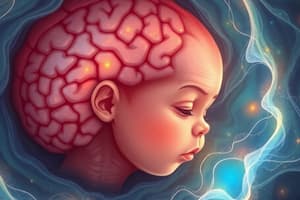Podcast
Questions and Answers
What is a genetic disorder that can cause pediatric hydrocephalus?
What is a genetic disorder that can cause pediatric hydrocephalus?
- Intraventricular hemorrhage
- Meningitis
- Arachnoid cyst
- Aqueductal stenosis (correct)
Which symptom of pediatric hydrocephalus is often accompanied by fussiness and restlessness?
Which symptom of pediatric hydrocephalus is often accompanied by fussiness and restlessness?
- Lethargy
- Irritability (correct)
- Seizures
- Vomiting
What is the primary purpose of imaging studies in the diagnosis of pediatric hydrocephalus?
What is the primary purpose of imaging studies in the diagnosis of pediatric hydrocephalus?
- To rule out other neurological conditions
- To visualize ventricles and brain structures (correct)
- To determine the underlying cause of hydrocephalus
- To assess developmental milestones
What is the most common type of shunt used to treat pediatric hydrocephalus?
What is the most common type of shunt used to treat pediatric hydrocephalus?
Which of the following is a potential complication of a ventriculoperitoneal (VP) shunt?
Which of the following is a potential complication of a ventriculoperitoneal (VP) shunt?
What is the primary purpose of a neurological examination in the diagnosis of pediatric hydrocephalus?
What is the primary purpose of a neurological examination in the diagnosis of pediatric hydrocephalus?
Which of the following is not a common cause of pediatric hydrocephalus?
Which of the following is not a common cause of pediatric hydrocephalus?
What is the primary purpose of endoscopic third ventriculostomy (ETV) in the treatment of pediatric hydrocephalus?
What is the primary purpose of endoscopic third ventriculostomy (ETV) in the treatment of pediatric hydrocephalus?
Flashcards are hidden until you start studying
Study Notes
Causes of Pediatric Hydrocephalus
- Genetic disorders: e.g. aqueductal stenosis, X-linked hydrocephalus, Dandy-Walker syndrome
- Infections: e.g. meningitis, ventriculitis, TORCH infections (toxoplasmosis, rubella, cytomegalovirus, herpes simplex)
- Bleeding: e.g. intraventricular hemorrhage (IVH), subarachnoid hemorrhage
- Tumors: e.g. brain tumors, spinal cord tumors
- Trauma: e.g. head trauma, spinal cord injury
- Other: e.g. arachnoid cysts, vein of Galen malformations
Symptoms of Pediatric Hydrocephalus
- Increased head circumference: rapid growth in head size, especially in infants
- Vomiting: often projectile
- Irritability: fussiness, restlessness
- Lethargy: excessive sleepiness
- Seizures: rare, but can occur in some cases
- Developmental delays: delayed milestones, such as sitting, standing, or walking
- Vision problems: e.g. strabismus, nystagmus
- Other: e.g. poor feeding, sleep disturbances
Diagnosis of Pediatric Hydrocephalus
- Imaging studies: e.g. ultrasound, CT, MRI, to visualize ventricles and brain structures
- Physical examination: e.g. measurement of head circumference, assessment of fontanelles
- Neurological examination: e.g. assessment of reflexes, tone, and developmental milestones
- Laboratory tests: e.g. blood tests to rule out infections or other underlying conditions
Treatment Options for Pediatric Hydrocephalus
- Shunt placement: surgical insertion of a shunt to drain excess cerebrospinal fluid (CSF) from the brain
- Endoscopic third ventriculostomy (ETV): minimally invasive procedure to create a hole in the floor of the third ventricle to allow CSF to flow
- Ventriculoperitoneal (VP) shunt: most common type of shunt, drains CSF from the ventricles to the abdomen
- Ventriculoatrial (VA) shunt: drains CSF from the ventricles to the heart
- Other: e.g. repeated lumbar punctures, medications to reduce CSF production
Causes of Pediatric Hydrocephalus
- Aqueductal stenosis, X-linked hydrocephalus, and Dandy-Walker syndrome are genetic disorders that can cause pediatric hydrocephalus.
- Meningitis, ventriculitis, and TORCH infections are types of infections that can lead to pediatric hydrocephalus.
- Intraventricular hemorrhage (IVH) and subarachnoid hemorrhage are types of bleeding that can cause pediatric hydrocephalus.
- Brain tumors and spinal cord tumors can cause pediatric hydrocephalus.
- Head trauma and spinal cord injury are types of trauma that can lead to pediatric hydrocephalus.
- Arachnoid cysts and vein of Galen malformations are other causes of pediatric hydrocephalus.
Symptoms of Pediatric Hydrocephalus
- Rapid growth in head size, especially in infants, can be a sign of pediatric hydrocephalus.
- Projectile vomiting is a common symptom of pediatric hydrocephalus.
- Fussiness and restlessness are indicative of irritability in pediatric hydrocephalus patients.
- Excessive sleepiness is a symptom of pediatric hydrocephalus.
- Seizures can occur in some cases of pediatric hydrocephalus.
- Delayed milestones, such as sitting, standing, or walking, are signs of developmental delays in pediatric hydrocephalus.
- Strabismus and nystagmus are vision problems associated with pediatric hydrocephalus.
- Poor feeding and sleep disturbances are other symptoms of pediatric hydrocephalus.
Diagnosis of Pediatric Hydrocephalus
- Ultrasound, CT, and MRI are imaging studies used to visualize ventricles and brain structures.
- Measurement of head circumference and assessment of fontanelles are part of a physical examination.
- Assessment of reflexes, tone, and developmental milestones are components of a neurological examination.
- Blood tests are used to rule out infections or other underlying conditions.
Treatment Options for Pediatric Hydrocephalus
- Shunt placement involves surgically inserting a shunt to drain excess cerebrospinal fluid (CSF) from the brain.
- Endoscopic third ventriculostomy (ETV) is a minimally invasive procedure to create a hole in the floor of the third ventricle to allow CSF to flow.
- Ventriculoperitoneal (VP) shunt is the most common type of shunt, draining CSF from the ventricles to the abdomen.
- Ventriculoatrial (VA) shunt drains CSF from the ventricles to the heart.
- Repeated lumbar punctures and medications to reduce CSF production are other treatment options.
Studying That Suits You
Use AI to generate personalized quizzes and flashcards to suit your learning preferences.




